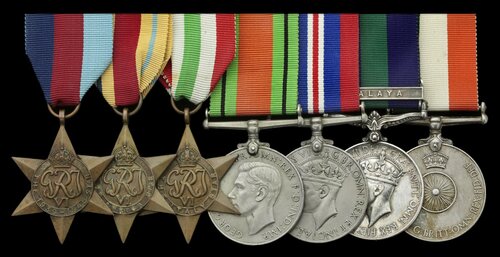
Auction: 21002 - Orders, Decorations and Medals
Lot: 143
Seven: Sergeant L. Rai 2nd Battalion, 7th Gurkha Rifles
1939-45 Star; Africa Star; Italy Star; Defence and War Medals 1939-45; General Service 1918-62, 1 clasp, Malaya (21138061 Sgt. Lalbahadur Rah [sic] 7.G.R.); Indian Independence 1947 (21138051 Sjt. Lalbahadur Rai. G.R.), very fine (7)
It is assumed that Rai either avoided capture at Tobruk or was held back in Egypt with the Battalion echelon as a reinforcement and therefore able to accompany the newly raised 2nd Battalion that took part in the Italian campaign. He was also one of the very few Senior NCOs of the Battalion that opted to serve with the British Army in 1948 and subsequently take part in the Malay Emergency.
Following the outbreak of the Second World War, the 2nd Battalion, 7th Gurkha Rifles initially deployed to Basra, Iraq in mid-April 1941. Following the declaration of war by Iraq, the Battalion undertook a series of minor operations until the Iraqi Government sought an armistice at the end of May. The Battalion then moved to Baghdad from where it was employed in the protection of oilfields. In late August, the 2nd Battalion, under its former Battalion Commander Major-General Bill Slim, took part in the invasion of Iran to forestall a possible German occupation and link-up with Soviet Forces. Thereafter, the Battalion returned to Iraq, where it was continuously employed in the construction of field defences in the event of a German breakthrough from the Caucasus. At the end of April 1942, the Battalion moved by road and rail to Egypt, where it became part the 11th Indian Infantry Brigade and joined the Tobruk Garrison at the beginning of June. On 20 June, the Germans mounted a ferocious attack upon the defenders and by nightfall Tobruk had been captured. The following morning, on 21 June, the Garrison surrendered. The Battalion, cut off from its superior Headquarters and its own echelon, remained totally unaware of the situation. From dawn on 21 June, each of the four company defences were attacked sequentially until they ran out of ammunition and were overwhelmed leaving no alternative but to surrender. Shortly after mid-day on 21 June the Battalion Commander gave the order to surrender and for the second time in its very short history the 2nd Battalion was marched-off into captivity and held in North Africa or moved to Italy. Nevertheless, a large number of Gurkhas managed to escape and evade capture.
Now, for the second time, a 2nd Battalion was reformed for subsequent service in Italy from 1944, which included the first Battle of Cassino and advance along the Adriatic Coast to Rimini and the Gothic Line. The Battalion was then deployed to Greece in early 1945 to help restore order before returning to India. It was selected as one of the four Gurkha regiments to be transferred to the British Army, but less than 100 Gurkha officers and soldiers opted to go with the 2nd Battalion when it moved from India to Malaya in early 1948, where, along with the 1st Battalion, it was to be converted into a Field Artillery Regiment as part of the plan for an all Gurkha division. However, the Malay Emergency, which commenced in June 1948, reversed this decision and the unit reverted to remaining as infantry.
Subject to 20% VAT on Buyer’s Premium. For more information please view Terms and Conditions for Buyers.
Sold for
£160
Starting price
£110




